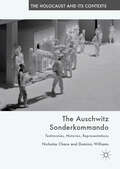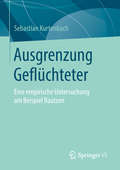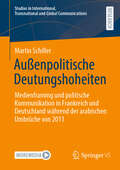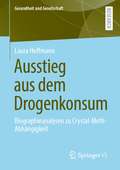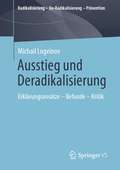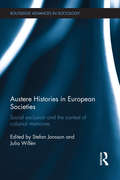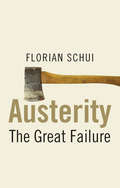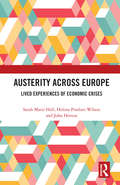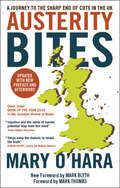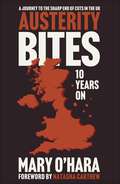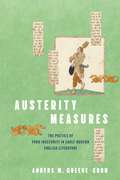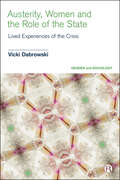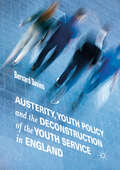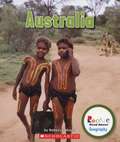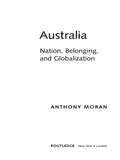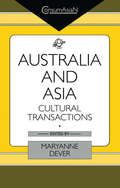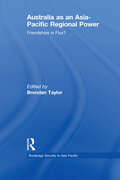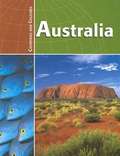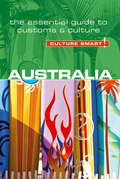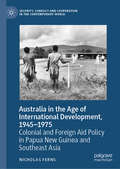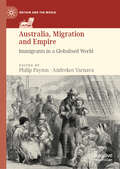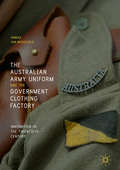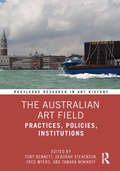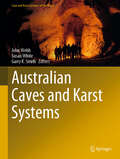- Table View
- List View
The Auschwitz Sonderkommando: Testimonies, Histories, Representations (The Holocaust and its Contexts)
by Nicholas Chare Dominic WilliamsThis book is the first to bring together analyses of the full range of post-war testimony given by survivors of the Sonderkommando of Auschwitz-Birkenau. The Auschwitz Sonderkommando were slave labourers in the gas chambers and crematoria, forced to process and dispose of the bodies of those who were murdered. They have been central to a number of key topics in post-war debates about the Shoah: collaboration, moral compromise and survival, resistance, representation, and the possibility of bearing witness. Their testimony however has mostly met with a reluctance to engage in depth with it. Moving from testimonies produced within the event, the Scrolls of Auschwitz and the Sonderkommando photographs, to testimonies given at trials and for video archives, and to the paintings of David Olère and the film Shoah by Claude Lanzmann, this book demonstrates the importance of their witnessing in the post-war memory of the Holocaust, and provides vital new insights into the questions of representation, memory, gender, and the Shoah.
Ausgrenzung Geflüchteter: Eine empirische Untersuchung am Beispiel Bautzen
by Sebastian KurtenbachDer Band beantwortet die Frage, wie einzelne Kommunen zu Orten der Ausgrenzung z. B. für Flüchtlinge werden. Hierzu werden am Beispiel der ostsächsischen Stadt Bautzen Ergebnisse einer Mixed-Methods Studie präsentiert, in der sowohl Survey-Daten als auch Medienberichte, Zeitungsartikel, teilnehmende Beobachtungen und über 100 leitfadengestützte Interviews mit Bürgerinnen und Bürgern, Geflüchteten, Politikern sowie Vertretern der Zivilgesellschaft und öffentlicher Einrichtungen ausgewertet werden.Der Inhalt• Forschungsstand• Forschungsdesign• Beschreibung des Fallbeispiels• Medienanalyse• Analyse des politischen Diskurses• Auswertung qualitativer Interviews• Normalisierungspraktiken. Ausgrenzung als AlltagDie Zielgruppen• Lehrende und Studierende der Soziologie, Stadtsoziologie, Politikwissenschaften und Soziale Arbeit• Praktikerinnen und Praktiker in der politischen Bildung, Kommunalverwaltung und Sozialen ArbeitDer AutorDr. Sebastian Kurtenbach ist Vertretungsprofessor für Politikwissenschaften/Sozialpolitik mit Schwerpunkt Kommunalpolitik und kommunale Sozialpolitik an der Fachhochschule Münster. Zuvor war er wissenschaftlicher Mitarbeiter am Institut für interdisziplinäre Konflikt- und Gewaltforschung (IKG) der Universität Bielefeld.
Außenpolitische Deutungshoheiten: Medienframing und politische Kommunikation in Frankreich und Deutschland während der arabischen Umbrüche von 2011 (Studies in International, Transnational and Global Communications)
by Martin SchillerIn welchem Verhältnis stehen nationale Außen- und Sicherheitspolitik und Medien im Fall einer internationalen Umbruchssituation? Dieser Frage geht Martin Schiller am Beispiel der Berichterstattung französischer und deutscher Qualitätsmedien zum sogenannten Arabischen Frühling 2011 nach. Den theoretischen Zugang bildet die Indexing-Forschung, die postuliert, dass sich Leitmedien insbesondere in außenpolitischen Belangen am Meinungsspektrum innerhalb der politischen Eliten orientieren. Im Kontrast dazu zeigen frühere Befunde, dass in Umbruchssituationen von regionaler oder globaler Tragweite ein als unumstößlich geltender Elitenkonsens von Medien wirkmächtig infrage gestellt werden kann. Anhand eines innovativen „Indexing-Tendenz-Modells&“ untersucht der Autor, wie sich mediale und politische Konstellationen im Vergleich zwischen Frankreich und Deutschland und im Kontext der Umbrüche in Tunesien, Ägypten und Libyen im Frühjahr 2011 ausgestalten. Es zeigt sich, dass die Orientierung von Medien am außenpolitischen Elitendiskurs wesentlich durch die spezifischen Kommunikationsressourcen der Akteure im jeweiligen politisch-medialen System bedingt sind. Außerdem entwickelt das spezifische Framing der MENA-Region ein gewisses Eigenleben. Der inhaltliche Gehalt dieser Deutungsmuster trägt wesentlich dazu bei, ob sich zwischen medialen Stimmen und politischen Entscheidungsträgern in Paris oder Berlin Konflikte oder Konsens in der Bewertung des Arabischen Frühlings einstellen.
Ausstieg aus dem Drogenkonsum: Biographieanalysen zu Crystal-Meth-Abhängigkeit (Gesundheit und Gesellschaft)
by Laura HoffmannIn der vorliegenden Arbeit werden erstmals Biographieverläufe von ehemaligen Methamphetaminkonsumenten im deutschsprachigen Raum untersucht und wichtige Erkenntnisse im Bereich der qualitativen Drogen- und Suchtforschung zur Verfügung gestellt. Es werden verschiedene biographische Prozesse identifiziert, die zum Drogenkonsum der Befragten geführt sowie zu dessen Bewältigung beigetragen haben. Die Ergebnisse der Studie deuten darauf hin, dass zukünftig die Individualität der Suchtverläufe der Betroffenen stärker in den Fokus gerückt werden muss, um verbesserte Hilfsangebote für verschiedene Phasen ihrer Abhängigkeit zur Verfügung stellen zu können. Auf diese Art und Weise können die Inanspruchnahme von Versorgungsangeboten sowie auch die Chancen auf eine gelingende Bewältigung des Drogenkonsums verbessert werden.
Ausstieg und Deradikalisierung: Erklärungsansätze – Befunde – Kritik (Radikalisierung – De-Radikalisierung – Prävention)
by Michail LogvinovUm Ausstieg und Deradikalisierung von Mitgliedern extremistischer Formationen auslösen, begleiten und unterstützen zu können, bedarf es eines fundierten Wirkfaktoren- und Prozessverständnisses. Daher befasst sich der zweite Band unserer Reihe mit der Post-9/11-Deradikalisierungsforschung, arbeitet relevante Modelle sowie Befunde heraus und formuliert praktische und theoretische Implikationen.
Austere Histories in European Societies: Social Exclusion and the Contest of Colonial Memories (Routledge Advances in Sociology)
by Stefan Jonsson and Julia WillénIn recent years European states have turned toward more austere political regimes, entailing budget cuts, deregulation of labour markets, restrictions of welfare systems, securitization of borders and new regimes of migration and citizenship. In the wake of such changes, new forms of social inclusion and exclusion appear that are justified through a reactivation of differences of race, class and gender. Against this backdrop, this collection investigates contemporary understandings of history and cultural memory. In doing so, the reader will join the leading European contributors of this title in examining how crisis and decline in contemporary Europe trigger a selective forgetting and remodelling of the past. Indeed, Austere Histories in European Societies breaks new paths in scholarship by synthesising and connecting current European debates on migration, racism and multiculturalism. In addition to this, the authors present debates on cultural memory and the place of the colonial legacy within an extensive comparative framework and across the boundaries of the humanities and social sciences. This book will appeal to scholars and students across the social sciences and humanities, particularly in European studies, memory studies, sociology, postcolonial studies, migration studies, European history, cultural policy, cultural heritage, economics and political theory.
Austerity
by Florian SchuiAusterity is at the center of political debates today. Its defenders praise it as a panacea that will prepare the ground for future growth and stability. Critics insist it will precipitate a vicious cycle of economic decline, possibly leading to political collapse. But the notion that abstinence from consumption brings benefits to states, societies, or individuals is hardly new. This book puts the debates of our own day in perspective by exploring the long history of austerity-a popular idea that lives on despite a track record of dismal failure. Florian Schui shows that arguments in favor of austerity were-and are today-mainly based on moral and political considerations, rather than on economic analysis. Unexpectedly, it is the critics of austerity who have framed their arguments in the language of economics. Schui finds that austerity has failed intellectually and in economic terms every time it has been attempted. He examines thinkers who have influenced our ideas about abstinence from Aristotle through such modern economic thinkers as Smith, Marx, Veblen, Weber, Hayek, and Keynes, as well as the motives behind specific twentieth-century austerity efforts. The persistence of the concept cannot be explained from an economic perspective, Schui concludes, but only from the persuasive appeal of the moral and political ideas linked to it.
Austerity Across Europe: Lived Experiences of Economic Crises
by Sarah Marie Hall; Helena Pimlott-Wilson; John HortonDrawing together multidisciplinary research exploring everyday life in Europe during times of economic crisis, this book explores the ways in which austerity policies are lived and experienced - often alongside other significant social, political and personal change. With attention to the inequalities produced by these processes and the measures used by individuals, families and communities to help them ‘get by’, it also envisages hopeful, affirmative socio-political futures. Arranged around the themes of intergenerational relations and exchanges, ways of coping through crises, and community, civic and state infrastructures, Austerity Across Europe will appeal to social scientists with interests in everyday life, family practices, neoliberal state policy, poverty and socio-economic inequalities.
Austerity Bites: A Journey to the Sharp End of Cuts in the UK
by Mary O'HaraVoted one of the Guardian best books of 2014 by Owen Jones. After coming to power in May 2010, the Coalition government in the United Kingdom embarked on a drastic programme of cuts to public spending and introduced a raft of austerity measures that had profoundly damaging effects on much of the population. This bestselling book by award-winning journalist Mary O’Hara chronicles the true impact of austerity on people at the sharp end, based on her ‘real-time’ 12-month journey around the country just as the most radical reforms were being rolled out in 2012 and 2013. Drawing on hundreds of hours of compelling first-person interviews, with a broad spectrum of people ranging from homeless teenagers, older job-seekers, pensioners, charity workers, employment advisers and youth workers, as well as an extensive body of research and reports, the book explores the grim reality of living under the biggest shakeup of the welfare state in 60 years. with a new Foreword by Mark Blyth, Professor of International Political economy and International Studies at Brown University, USA, Austerity Bites dispels any notion that “we are all in this together” and offers an alternative to the dominant and simplistic narrative that we inhabit a country of “skivers versus strivers.
Austerity Bites 10 Years On: A Journey to the Sharp End of Cuts in the UK
by Mary O'HaraAusterity has proven deadly. Over the last decade, the damage caused by austerity measures in the UK has had a long-lasting and profound effect on many lives. The first edition of Austerity Bites offered on-the-ground reportage of one of the most significantly regressive economic strategies of any post-war government. Over a year Mary O’Hara toured the UK to gauge the immediate impact – and expectations of people affected – and found many clinging to the hope that austerity cuts would not last long as the damage became increasingly apparent. Alas, this was not how things unfolded. Instead, much of the Welfare State had its vital support systems systematically undermined. The public sector, including the NHS, is now on its knees. Schools are buckling under multiple structural and budgetary pressures. Councils – even big ones – are going broke. Homelessness is rampant. While Brexit, the pandemic, and war have no doubt impacted the economic health of the country, previous austerity cuts left the UK less prepared to weather such extraordinary events. With new commentary, Austerity Bites 10 Years On assesses on the true scale of the damage these policies have inflicted on the country’s most vulnerable groups, public institutions and on the wider society. It reflects on where we have been, where we are now and what needs to happen next to undo the damage and avoid the same mistakes again.
Austerity Measures: The Poetics of Food Insecurity in Early Modern English Literature
by Anders M. Greene-CrowExplores how early modern writers used poetry to fight food insecurityAusterity Measures explores how early modern writers used poetic form as a tool to fight extreme food insecurity. Authors such as Thomas Tusser, George Herbert, Robert Herrick, Anne Bradstreet, and Thomas Tryon witnessed the privatization of public farmland, rising food prices amidst uncontrolled inflation, mass starvation in nascent North American colonies, and the racist violence of the Caribbean plantation slavery system. Anders M. Greene-Crow shows how these authors experimented with literary form in an effort to change readers’ beliefs and behaviors with regard to food ethics.By examining this history, Greene-Crow sheds new light on both modern-day food ethics and activism’s place in literary writing. This book traces how authors’ solutions to food insecurity turned away from structural models of communal care and toward the now-dominant consumer-capitalist model championing individual dietary choice. Simultaneously, he reveals why literary criticism began to discount literature’s power as a tool for social change. The New Critical school, whose close reading methodology dominates literary analysis, arose out of Southern Agrarianism, a movement that sought to return the South to antebellum structures of racial hierarchy and labor exploitation that took shape in the early modern period. These intersectional labor politics underlie close reading, continuing to limit critics’ understanding of how literary form produces social change, and reinforcing the scarcity culture of literature departments today.By recovering poetry’s role as a force for affecting readers’ relationship to one of their most basic needs—the need to eat—Austerity Measures develops an alternative methodology that takes writers’ material conditions into account in analyzing form.
Austerity, Women and the Role of the State: Lived Experiences of the Crisis (Gender and Sociology)
by Vicki DabrowskiUsing interviews with women from diverse backgrounds, Dabrowski makes an invaluable contribution to the debates around the gendered politics of austerity in the UK. Exploring the symbiotic relationship between the state’s legitimization of austerity and women’s everyday experiences, she reveals how unjust policies are produced, how alternatives are silenced and highlights the different ways in which women are used or blamed. By understanding austerity as more than simply an economic project, this book fills important gaps in existing knowledge on state, gender and class relations in the context of UK austerity. Austerity, Women and the Role of the State is shortlisted for the 2021 BSA Philip Abrams Memorial Prize.
Austerity, Youth Policy and the Deconstruction of the Youth Service in England
by Bernard DaviesThis timely book presents a vital analysis of the politics, policy and practice of youth work services in England and the impacts of the austerity agenda introduced after the 2007-08 financial crisis. Davies frames his research within the ideological, political and economic context of the last decade, contemplating the prescriptions of neoliberalism, and various other socio-political developments. He illustrates how wider government policies, programmes and initiatives have marred the purposes and methods of the Youth Service and youth work facilities, forging connections with what this means for young people and youth work. Unique in its depth and detail, this book is one of the first comprehensive, evidenced and up-to-date accounts of UK Youth Policy. It is an essential and invaluable resource for youth educators, researchers, service managers, practitioners and activists, as well as scholars and students of youth studies, social policy, public policy, and history.
Australia (Rookie Read-About Geography)
by Rebecca E. HirschPresents a simple introduction to Australia, focusing on its geographical features, people and native animals.
Australia: Nation, Belonging, and Globalization (Global Realities #Vol. 1)
by Anthony MoranIn this book Anthony Moran traces the development of contemporary Australian society in the global age, focusing on four major themes: settler/indigenous relations; economics and culture since the 1980s and their impact on national identity; the effects of increasing diversity fostered by globalization; and the transformation of Australian social space wrought by globalization.
Australia and Asia: Cultural Transactions (ConsumAsian Series #No. 5)
by Maryanne DeverFocuses on a series of interactions and exchanges - whether philosophical, political, aesthetic, or commercial - between Australia and the cultures of the Asia-Pacific region.
Australia as an Asia-Pacific Regional Power: Friendships in Flux? (Routledge Security in Asia Pacific Series)
by Brendan TaylorDuring recent years, in its traditional role as an important Asia-Pacific regional power, Australia has had to cope with a rapidly changing external security environment and a series of new challenges, including a rising China, an increasingly assertive United States, and most notably the Global War against Terror. This book considers the changing nature of Australia’s identity and role in the Asia-Pacific, and the forces behind these developments, with particular attention towards security alignments and alliance relationships. It outlines the contours of Australia’s traditional role as a key regional middle power and the patterns of its heavy reliance on security alignments and alliances. Brendan Taylor goes on to consider Australia’s relationships with other regional powers including Japan, China, Indonesia and India, uncovering the underlying purposes and expectations associated with these relationships, their evolving character – particularly in the post Cold War era – and likely future directions. He discusses the implications for the region of Australia’s new ‘Pacific doctrine’ of intervention, whether Australia’s traditional alliance preferences are compatible with the emergence of a new East Asian security mechanism, and the impact of new, transnational and non-traditional security challenges such as terrorism and failed states.
Australia (Countries and cultures)
by Tracey BoraasAn introduction to the geography, history, economy, culture, and people of Australia.
Australia - Culture Smart!
by Barry PenneyAustralia is different--a vast island-continent with distances so great that the capital of Western Australia is closer to Singapore than it is to Sydney. The landscape embraces magnificent tropical rainforests and deserts the size of several European states; temperate areas that sustain a flourishing wine industry, making Australia the world's fourth largest wine exporter; a sixteen-thousand-mile coastline of breathtaking beaches; and its unique fauna is testament to the country's "down-underness." Indigenous Australians have inhabited the continent for more than fifty thousand years, yet European settlement is just over two hundred years old. Since the end of the Second World War the country has opened its doors to a hugely diverse immigrant population and slowly shaken off the mantle of British influence, transforming what was perhaps one of the dullest nations into one of the most stimulating. The Australians' old settler mentality--regarding themselves as "battlers," and embarrassed by their lack of sophistication--has given way to a new national confidence. The achievements of Australia's artists, sportspeople, entertainers, scientists, and businesspeople puts them on the global stage. Despite the diversity of ethnicities there is a pervasive homogeneity among Australians: a generosity of spirit and a forthrightness, sometimes disarming for the visitor. A sense of fairness and equality is valued, as is the ability not to take oneself too seriously. Culture Smart! Australia introduces you to a young nation with one of the world's highest standards of living, "where people work to live" in order to enjoy a lifestyle that many across the globe covet, and in which Australians take great pride (and don't mind telling you about).
Australia in the Age of International Development, 1945–1975: Colonial and Foreign Aid Policy in Papua New Guinea and Southeast Asia (Security, Conflict and Cooperation in the Contemporary World)
by Nicholas FernsThis book examines Australian colonial and foreign aid policy towards Papua New Guinea and Southeast Asia in the age of international development (1945–1975). During this period, the academic and political understandings of development consolidated and informed Australian attempts to provide economic assistance to the poorer regions to its north. Development was central to the Australian colonial administration of PNG, as well as its Colombo Plan aid in Asia. In addition to examining Australia’s perception of international development, this book also demonstrates how these debates and policies informed Australia’s understanding of its own development. This manifested itself most clearly in Australia’s behavior at the 1964 United Nations Conference on Trade and Development (UNCTAD). The book concludes with a discussion of development and Australian foreign aid in the decade leading up to Papua New Guinea’s independence, achieved in 1975.
The Australia-Japan Political Alignment: 1952 to the Present (Routledge Studies in the Modern History of Asia)
by Alan RixIn this new volume, Alan Rix examines the renewal of post-war contacts between Australia and Japan and the resolution of wartime issues in the 1950s. He shows how some major bilateral negotiations highlight the tensions involved in forging a strong relationship, while extensive analysis of the machinery of diplomacy (the administrative, political and legal framework) indicates the depth of bilateral ties. Also covered are the close consultation and diplomatic dealings over the decades and the personal connections between leaders.
Australia, Migration and Empire: Immigrants in a Globalised World (Britain and the World)
by Philip Payton Andrekos VarnavaThis edited collection explores how migrants played a major role in the creation and settlement of the British Empire, by focusing on a series of Australian case studies. Despite their shared experiences of migration and settlement, migrants nonetheless often exhibited distinctive cultural identities, which could be deployed for advantage. Migration established global mobility as a defining feature of the Empire. Ethnicity, class and gender were often powerful determinants of migrant attitudes and behaviour. This volume addresses these considerations, illuminating the complexity and diversity of the British Empire’s global immigration story. Since 1788, the propensity of the populations of Britain and Ireland to immigrate to Australia varied widely, but what this volume highlights is their remarkable diversity in character and impact. The book also presents the opportunities that existed for other immigrant groups to demonstrate their loyalty as members of the (white) Australian community, along with notable exceptions which demonstrated the limits of this inclusivity.
The Australian Army Uniform and the Government Clothing Factory: Innovation In The Twentieth Century
by Anneke Van MosseveldThis book reveals the business history of the Australian Government Clothing Factory as it introduced innovative changes in the production and design of the Australian Army uniform during the twentieth century. While adopting a Schumpeterian interpretation of the concept of innovation, Anneke van Mosseveld traces the driving forces behind innovation and delivers a comprehensive explanation of the resulting changes in the combat uniform. Using an array of archival sources, this book displays details of extensive collaborations between the factory, the Army and scientists in the development of camouflage patterns and military textiles. It uncovers a system of intellectual property management to protect the designs of the uniform, and delivers new insights into the wider economic influences and industry linkages of the Government owned factory.
The Australian Art Field: Practices, Policies, Institutions (Routledge Research in Art History)
by Tony Bennett Deborah Stevenson Fred Myers Tamara WinikoffThis book brings together leading scholars and practitioners to take stock of the frictions generated by a tumultuous time in the Australian art field and to probe what the crises might mean for the future of the arts in Australia. Specific topics include national and international art markets; art practices in their broader social and political contexts; social relations and institutions and their role in contemporary Australian art; the policy regimes and funding programmes of Australian governments; and national and international art markets. In addition, the collection will pay detailed attention to the field of indigenous art and the work of Indigenous artists. This book will be of interest to scholars in contemporary art, art history, cultural studies, and Indigenous peoples.
Australian Caves and Karst Systems (Cave and Karst Systems of the World)
by Susan White John Webb Garry K. SmithThis book, part of the series Cave and Karst Systems of the World, begins with a review of the interaction between people and caves in Australia (including conservation), followed by descriptions of the spectacular cave diving sites, before comprehensively covering all the major carbonate and noncarbonate karst areas, subdivided by rock type and region, and including the origin of the caves. This is followed by broad overviews of cave minerals and speleothems, cave biology and cave fossils. Each section was written by one or more specialists in the topic and is illustrated by clear diagrams and superb colour photos. The book emphasises the unique aspects of the Australian karst, including the variability in the age of the caves (very old to very young) and the impact of isolation on the stygofauna, as well as the vertebrate fossils preserved in the caves. Written in an easy-to-read style, the book is a primary reference guide to Australian karst and represents a valuable asset for anyone interested in the topic, not only cavers and academics.
